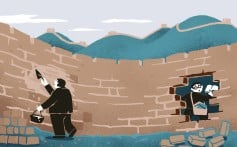
WHO okayed vaccines including CanSinoBIO jab





 Rightways - Sowing the seeds of Success:
Think Global, Act Local; Change & Grow Rich; Sow as You Reap & Soar High!
Richard Tan
MBA(UK), BCA(NZ), AMA(USA),MMIM
Rightways - Sowing the seeds of Success:
Think Global, Act Local; Change & Grow Rich; Sow as You Reap & Soar High!
Richard Tan
MBA(UK), BCA(NZ), AMA(USA),MMIM
The Most EFFECTIVE WAYS to Prevent a Security Data Breach
This has to be done quickly to prevent more of such data breaches before it is too late and puts national security at risk.
Related:
PETALING JAYA: The public are outraged over another alleged data leak containing the information of 22.5 million Malaysians born between 1940 and 2004, stolen from the National Registration Department (NRD).
Many are anticipating more scam calls and SMSes as well as fraudulent online transactions to occur over the breach.
Businessman Amirul Asraf, 31, from Wangsa Melawati, said such incidents were the root cause for many the scam calls people are receiving on a daily basis.
“With these data, scammers can convince people that they are calling from the banks, courts, police and authorities. This will make people’s lives harder.
“I read a case where a poor man who obtained assistance from his local assemblyman was cheated after a scammer emptied him out. The assemblyman had to help the victim again as a result.
“These scammers are heartless. They don’t care if they take a lot or a little or whom they trick, as long as they get the money,” he said.
Software engineer Ahmad Ridzwan, 30, from Bukit Jalil, could only say “Malaysia Boleh” in relation to the leak taking place.
“Not sure what else to comment. This is the worst possible leak because our identifiable data is out in the open and the identity card is the most important one of all,” he said.
Sales executive Shivaendra Gunasegaram, 30, from Petaling Jaya, said smartphones and social media companies already had all data pertaining to the individuals.
As such, all personal information was accessible to many people, he said.
“As long as there are no unauthorised transactions from our bank accounts, I feel that there’s nothing to worry about.
“The advantage of being poor is that they probably won’t target my account because there’s not much in it,” he said jokingly.
Meanwhile, the data leak report continued to create a buzz in online forums and on social media, with many people expressing their unhappiness over the government’s inability to protect vital information from being leaked repeatedly over the years.On Facebook, user Zaidi Rudy said: “Brace yourselves, scam calls are coming in.”
Dennis Ooi said: “Was SOLD mean somebody have to go jail. Any action taken on those responsible. Or tangkap lepas again.”
Wan Meng Lee questioned: “Why the rakyat confidential information can be sold off is it not kept safely omg.”
Abdul Hamid said: “If they know the data being sold, they definitely know who is the seller.”
In the Lowyat forum, user bananjoe said: “Habis go and overhaul the whole new mykad. This is epic ridiculous. Government IT staff doing what ???”
Sycamore said: ”So absurd. But why am I not surprised? Absurdity is the reality.”
Radiowarrior1337 said: “This needs to kena and people head must roll. Tidak apa attitude and biar la dah hack kan so mari lepak minum teh now to discuss what scenario he obtains the data.”
 Rightways - Sowing the seeds of Success:
Think Global, Act Local; Change & Grow Rich; Sow as You Reap & Soar High!
Richard Tan
MBA(UK), BCA(NZ), AMA(USA),MMIM
Rightways - Sowing the seeds of Success:
Think Global, Act Local; Change & Grow Rich; Sow as You Reap & Soar High!
Richard Tan
MBA(UK), BCA(NZ), AMA(USA),MMIM
This book argues for computer-aided collaborative country research based on the science of complex and dynamic systems. It provides an in-depth discussion of systems and computer science, concluding that proper understanding of a country is only possible if a genuinely interdisciplinary and truly international approach is taken; one that is based on complexity science and supported by computer science. Country studies should be carefully designed and collaboratively carried out, and a new generation of country students should pay more attention to the fast growing potential of digitized and electronically connected libraries. In this frenzied age of globalization, foreign policy makers may – to the benefit of a better world – profit from the radically new country studies pleaded for in the book. Its author emphasizes that reductionism and holism are not antagonistic but complementary, arguing that parts are always parts of a whole and a whole has always parts.
 Comprehending the complexity of countries is a monumental contribution to deep thinking about countries as complex and dynamic systems.
Comprehending the complexity of countries is a monumental contribution to deep thinking about countries as complex and dynamic systems.
Andrew Sheng writes on global issues from an Asian perspective. The views expressed here are the writer’s own.
Related posts:
Sun Tzu - The Art of War Explained The Art of War is the most influential treatise on war ever written, consisting of 13 chapter
 Rightways - Sowing the seeds of Success:
Think Global, Act Local; Change & Grow Rich; Sow as You Reap & Soar High!
Richard Tan
MBA(UK), BCA(NZ), AMA(USA),MMIM
Rightways - Sowing the seeds of Success:
Think Global, Act Local; Change & Grow Rich; Sow as You Reap & Soar High!
Richard Tan
MBA(UK), BCA(NZ), AMA(USA),MMIM
China’s search for technological mastery will succeed because it is essentially replicating the actual history of the economics and policies that led the United States to technological dominance, rather than the ideological history of what many Americans believe lies behind their success For years, American policymakers and pundits have believed China’s search for technological mastery or supremacy is doomed to fail or at least be consigned forever to mediocrity and also-ran status. This belief lies behind the strategy, first put forward by the Donald Trump administration, and now followed by Joe Biden’s White House, to restrict or ban the transfer of crucial technologies, notably the most advanced semiconductors and their production methods. And yet, paradoxically, China is bound to succeed, despite the inevitable hiccups and setbacks, because it is essentially replicating the actual history of the economics and policies that led the United States to technological dominance, rather than the ideological history of what many Americans believe lies behind their success. They have applied their own ideological models to predict China’s supposedly “inevitable” failure, instead of using their own actual history of American technology and science, and economic policy, to analyse China’s development and acquisition of key technologies in the 21st century. This is perhaps not surprising. Rich, powerful and successful people usually tell a different story about how they get to where they are to what actually happened to them. It’s human nature. China’s Great Firewall It’s generally believed that free enterprise is the necessary and sufficient condition for hi-tech industries. This means: the free flow of information and talent; open market; no or minimal government intervention, also called deregulation; and intellectual property rights protection. It’s believed only the market can choose winners and eliminate the losers, and that any state attempt to choose “national champions” is bound to fail and to be wasteful. China’s so-called Great Firewall of the internet stands as both an actual barrier and a potent symbol that is antithetical to all those fundamental neoliberal assumptions, which, granted, are being increasingly challenged and even undermined, even among some US professional economists and historians. However, if you believe in all those assumptions, you of course will logically argue that China is bound to fail. But is it? Let’s consider the historical reference: the Great Wall of China. It has been alternately argued that it was built to resist foreign invaders, and/or to keep in the domestic population. Either way, it was too porous to be truly effective.

 The Silicon Valley folklore is that of a lone maverick who has a great idea and pushes it to fruition, and in the process, creates a multibillion-dollar industry. That cannot be further from the assumption behind Japanese-Korean-Chinese state industrial policy, according to which innovation is a collective enterprise, not one of individual genius or charisma. It’s all about the sustained commitment of public resources and collective talent between the state and the private sector.
It’s a common criticism that such a policy is wasteful; it often backs the wrong technologies and industries. That’s true. However, the Silicon Valley model is also prone to periodic market euphoria, mania, panic and crashes, from the dotcom implosion to the current ongoing crypto-crashes. I will leave it to economic historians and econometricians to determine whether the state or non-state model is more wasteful or destructive.
Conclusions
Belatedly, the Biden administration is slowly realising that whether it’s containment against China or competition with it, the horse has bolted out of the barn already. That is why despite its hostile rhetoric, it has no coherent policy on how to deter or delay China’s technological drive for mastery or supremacy. This conflict cuts to the very ideological self-beliefs of the two countries. Only time will tell how it will turn out.
However, restricting or banning technological transfer will not work. The great British historian Arnold Toynbee famously wrote that it was usually countries or civilisations confronted with great or even mortal challenges that prevailed and prospered in history, not those that were well-endowed with rich resources. Denying China access to vital technologies at this late stage will simply force it to develop its own domestic capabilities. That won’t make it weaker, only stronger and more self-reliant.
For years, American policymakers and pundits have believed China’s search for technological mastery or supremacy is doomed to fail or at least be consigned forever to mediocrity and also-ran status. This belief lies behind the strategy, first put forward by the Donald Trump administration, and now followed by Joe Biden’s White House, to restrict or ban the transfer of crucial technologies, notably the most advanced semiconductors and their production methods.
And yet, paradoxically, China is bound to succeed, despite the inevitable hiccups and setbacks, because it is essentially replicating the actual history of the economics and policies that led the United States to technological dominance, rather than the ideological history of what many Americans believe lies behind their success.
The Silicon Valley folklore is that of a lone maverick who has a great idea and pushes it to fruition, and in the process, creates a multibillion-dollar industry. That cannot be further from the assumption behind Japanese-Korean-Chinese state industrial policy, according to which innovation is a collective enterprise, not one of individual genius or charisma. It’s all about the sustained commitment of public resources and collective talent between the state and the private sector.
It’s a common criticism that such a policy is wasteful; it often backs the wrong technologies and industries. That’s true. However, the Silicon Valley model is also prone to periodic market euphoria, mania, panic and crashes, from the dotcom implosion to the current ongoing crypto-crashes. I will leave it to economic historians and econometricians to determine whether the state or non-state model is more wasteful or destructive.
Conclusions
Belatedly, the Biden administration is slowly realising that whether it’s containment against China or competition with it, the horse has bolted out of the barn already. That is why despite its hostile rhetoric, it has no coherent policy on how to deter or delay China’s technological drive for mastery or supremacy. This conflict cuts to the very ideological self-beliefs of the two countries. Only time will tell how it will turn out.
However, restricting or banning technological transfer will not work. The great British historian Arnold Toynbee famously wrote that it was usually countries or civilisations confronted with great or even mortal challenges that prevailed and prospered in history, not those that were well-endowed with rich resources. Denying China access to vital technologies at this late stage will simply force it to develop its own domestic capabilities. That won’t make it weaker, only stronger and more self-reliant.
For years, American policymakers and pundits have believed China’s search for technological mastery or supremacy is doomed to fail or at least be consigned forever to mediocrity and also-ran status. This belief lies behind the strategy, first put forward by the Donald Trump administration, and now followed by Joe Biden’s White House, to restrict or ban the transfer of crucial technologies, notably the most advanced semiconductors and their production methods.
And yet, paradoxically, China is bound to succeed, despite the inevitable hiccups and setbacks, because it is essentially replicating the actual history of the economics and policies that led the United States to technological dominance, rather than the ideological history of what many Americans believe lies behind their success.
They have applied their own ideological models to predict China’s supposedly “inevitable” failure, instead of using their own actual history of American technology and science, and economic policy, to analyse China’s development and acquisition of key technologies in the 21st century.
US cannot stop China's hi-tech rise | South China Morning Post
Alex Lo has been a Post columnist since 2012, covering major issues affecting Hong Kong and the rest of China. A journalist for 25 years, he has worked for various publications in Hong Kong and Toronto as a news reporter and editor. He has also lectured in journalism at the University of Hong Kong.
Related posts:
 Rightways - Sowing the seeds of Success:
Think Global, Act Local; Change & Grow Rich; Sow as You Reap & Soar High!
Richard Tan
MBA(UK), BCA(NZ), AMA(USA),MMIM
Rightways - Sowing the seeds of Success:
Think Global, Act Local; Change & Grow Rich; Sow as You Reap & Soar High!
Richard Tan
MBA(UK), BCA(NZ), AMA(USA),MMIM
The Art of War is an ancient guide on military strategy. Written by Sun Tzu a Chinese general and philosopher in the 5th Century B.C. It was created after he helped successfully defend the Chinese province of Wu against the province Chu.
The strategies in this book have been used for hundreds of years in military campaigns, business and sports. It is the ultimate guide on how to defeat an opposing force in whatever form that might take. Contrary to what we might expect, The Art of War actually advises to avoid fighting as much as possible by only striking targets that are weak and using manipulation to subdue the enemy.
Ultimately Sun Tzu teaches us how to have the advantage in conflict giving us the best possible chance of success. My hope for this production was to provide an exciting and digestible rendition of this ancient text that can help people learn these strategies for years to come.
Related:

Farewell: A woman saying goodbye to a relative aboard a train travelling to Przemysl, Poland, amid Russia’s invasion of Ukraine. — Reuters
https://www.thestar.com.my/opinion/columnists/along-the-watchtower/2022/04/27/propaganda-media---the-fog-of-war
Related posts:
 Rightways - Sowing the seeds of Success:
Think Global, Act Local; Change & Grow Rich; Sow as You Reap & Soar High!
Richard Tan
MBA(UK), BCA(NZ), AMA(USA),MMIM
Rightways - Sowing the seeds of Success:
Think Global, Act Local; Change & Grow Rich; Sow as You Reap & Soar High!
Richard Tan
MBA(UK), BCA(NZ), AMA(USA),MMIM